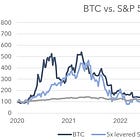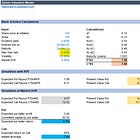🔎Always go back or never look back?
There are only two types of investors. Mr. Market will punish the larger of the two groups.
TLDR Summary
There are only two types of investors: those who bet on momentum and those who bet on mean reversion. You either believe the current trend will continue forever or you believe it will eventually stop and reverse. You either embrace extrapolation or you distrust it. You either see the world as structural or as cyclical.
Whether markets extend their current trend or revert to the mean depends heavily on the composition of market participants. The more investors who bet on momentum, the more susceptible markets become to sharp reversals. Conversely, the more investors who bet on mean reversion, the more likely trends are to persist.
The Return of Dr. Burry
Michael Burry got famous for predicting and capitalizing on the 2008 subprime crash. Personally, I think he was luckier than he was smart. Had the Fed reacted more proactively (like in 2020 for example), his long CDS positions might not have printed the way they did. But either way, he made a name for himself and gathered a large following.
He has been on and off social media over the years. Recently he returned by revealing a large bet against US technology stocks. In particular, he accuses Big Tech companies of accounting irregularities with respect to their revenue recognition and depreciation habits. His posts have millions of views. Many agree with his concerns. But: Equally many disagree with him. Many ridicule him, arguing that he has no idea about technology.
What struck me most when I observed this debate (as it does in many other debates as well) was that it’s always the same people lining up with each other against the same people on the other side. Normally you would expect that a new piece of information gets digested by people in many different ways based on their individual experience, innate intelligence and temperament. This should lead to a diverse set of opinions with meandering front lines.
That is clearly not happening. Investment opinions are just as tribal as political opinions. People are way more interested in confirming preconceptions than learning something new.
There are as many investment styles as there are investors out there. Some people like charts. Others like fundamentals. Some operate top-down, expressing macro themes through certain tickers. Others operate bottom-up, following individual stories. Some like value, others like growth. Some like a structured approach, others operate on gut feeling.
How is it possible to establish such a firm frontline with such a diverse set of approaches? How is this frontline determined?
I believe it ultimately all boils down to your personal preference between momentum and mean reversion. You may change your mind about these throughout your investor career. But at any given point in time you are mostly in the same bucket. Being aware of this will help you to break free from the bucket when it matters most. Let’s start with momentum.
Momentum
Momentum investors like to extrapolate what has been happening lately. They tend to think changes are structural.
They also tend to like chart analysis. Take Big Tech for example. How much of current investor excitement is about their fundamentals vs. their charts? Imagine you had to analyze Amazon, Google or Microsoft without consideration of their charts. You’d be allowed to consider their current share prices, but no historical prices. How excited would you be about them? Then consider their chart. How much more excited are you about them now? I’d reckon significantly more.
These are companies that have been growing revenues and earnings and double-digit rates. But they have also been buying this growth with higher and higher capital intensity. Their business models are commoditizing.
Where Google had an uncontested monopoly on organizing the internet before, its business model is now transforming into a digital utility company that is selling computing capacity. Computing capacity that is no different from Azure or AWS. You can train a model on any of these equally well. Product differentiation near zero.
Amazon’s cumulative post-SBC free cash flow since 2017 (!) has been negative.
And Microsoft investors have a huge Sam Altman key man risk to bear. The most important customers of these companies are running huge operating losses and have business models with little operating leverage. There is a lot to be concerned about in Big Tech stocks. But their charts heal these concerns for most investors involved.
Or take meme stocks. How much of the excitement for companies like Tesla, Palantir, Bitcoin/MicroStrategy or Lemonade is downstream from their charts?
Betting on Momentum is not something exclusive to the tech sector by the way. It’s just the hottest momentum space these days. Think about the excitement for commodity stocks in 2006 or 2022.
How many people assigned structural elements to these commodity bull markets back then? In 2006, people were certain about the infinite Chinese appetite for energy and steel. Then the emerging market bubble popped.
And in 2022, many investors were convinced that decades of underinvestment would lead to a new powerful and sustained commodity cycle. Naturally, my affection for mean reversion forced me to present the opposite case at that time.
I love betting on mean reversion. It’s both my greatest strength and my greatest weakness. It makes me contrarian by nature. It makes me avoid getting caught in the dumbest excesses. But it also makes me miss out on many big moves. Like this year for example.
Let’s talk more about mean reversion. When it works and when it doesn’t.
Mean reversion
Mean reversion investors are skeptical with respect to current trends. They are more anchored in historical prices and correlations. They tend to think changes are cyclical.
They are oftentimes right, especially when the momentum crowd mistakes cyclical trends for structural ones.
That is why shorting the VIX has a positive expected return.
That is why put options are systematically overpriced which makes selling them a winning strategy.
The chart below is also a compelling illustration of mean reversion in action. It shows the ratio of the equal-weight S&P 500 to the market-cap-weight S&P 500. Equal-weighting is a classic mean reversion strategy: it systematically overweights smaller-capitalization companies (which tend to have lagged recently) and underweights the largest ones. Over the past 50 years, this approach has outperformed the traditional market-cap-weighted index for the majority of the time.
However, if there are too many investors betting on mean reversion, their returns go negative. The devastating carry crashes of 2018 and 2020 are a proof to that. They wiped out tons of short volatility traders.
The same works in the other direction as well. In 2023/24 for example, too many investors sold (covered) call options because they doubted the bull market would have legs. Markets ate these investors alive. I covered that in great detail in the article below.
And just this year, the majority of institutional investors were caught wrong-footed betting on a mean reversion of international investment flows when they heavily sold out of US stocks upon the tariff drama in March and April. Only to see US vs. rest of world valuation discrepancies reaching even more excessive levels.
The mean reversion crowd usually says “It has run so far. How much more can it really go?” To which the momentum crowd typically just responds “yes”.
It’s a never ending war. But the key difference compared to an actual war is this: The smaller crowd is typically the one that wins.
Sincerely,
Rene
















Which one is the smaller crowd one right now?